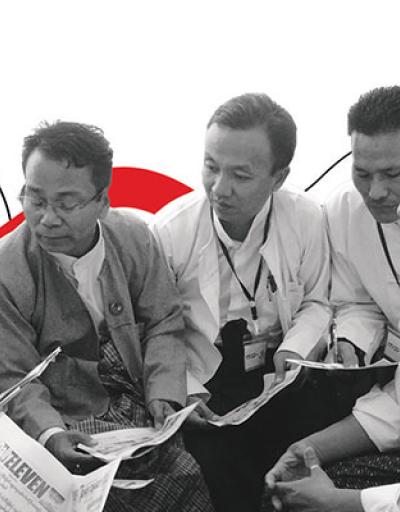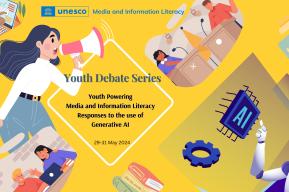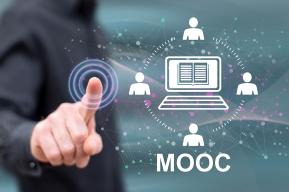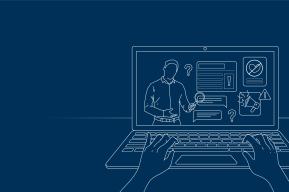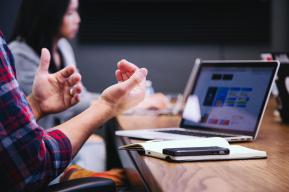The growing and urgent threat posed to societies by the rise of disinformation and misinformation and the misuse of social media has repeatedly made global headlines in recent years. We see this occurrence in connection with elections, health crises, climate change denial, rising hate speech and misogyny, to name a few. This is especially a concern in countries where the “Information Revolution” has triggered the most profound shifts in the manner, the modality and the quantity of media people consume.
With its media and information literacy programmes, UNESCO is in the vanguard of global efforts to bring significant changes at the policy or individual level. The ability to verify the source, credibility, accuracy and purpose of stories and information is becoming widely accepted as being as fundamental to any definition of human rights and freedoms, as reading and writing are.
In Kenya, UNESCO has worked during the past three years with Kenyan youth leaders, media professionals, parliamentarians and religious leaders to encourage the government to adopt a Draft MIL Policy and Strategy Document. Specific training sessions were conducted for leaders from Christian, Muslim and Hindu faiths, delivered with the Media Council of Kenya. ‘Religious leaders and media reach many people and a partnership between the two bodies can only be advantageous,’ said Mary Ann Mwangi, from St Paul’s University who attended the webinar for religious leaders.
A gathering was also organized for key legislators from the Parliamentary Committee on Information and Communication and Technology regarding the draft MIL Policy and Strategy Document for Kenya. Professor Levi Obonyo, Dean of the School of Communication and Journalism at Daystar said that ‘such national policies and strategies are fundamental to safeguarding the public interest, as the public will be trained on how to interrogate news and information they come across.”
Ian Ogonji, founder and CEO of the Kenyan website Youthing described the UNESCO training as “super informative and eye opening” and Winnie Wadera from Reducing HIV in Adolescents and Youth said it was “imperative young people were equipped with critical thinking”.
In Nigeria, the UNESCO field office persuaded the National Commission of Colleges of Education to embed media and information literacy as a compulsory component of all teacher trainings. In 2020 alone UNESCO trained teachers from over 100 different institutes in all six of Nigeria’s geopolitical zones. “It’s a huge achievement to get this mainstreamed into their curriculum,” said Yachat Sandra Nuhu, from the UNESCO Office in Abuja.
participated in UNESCO training on MIL
Media and Information Literacy offers effective strategies to tackle hate speech, fake news and misinformation that can foment radicalization and spark violence and conflict. Our forebears’ culture was oral – beating of drums, town criers, whistling, bush burning and the like. Content now comes via the Internet, TV, radio, e-books, magazines and conferences. With media continuing to proliferate, having the ability to assess what information is reliable grows more important every day. It’s crucial for people to become active and critical citizens who can participate in civic life and democracy.
For many governments, COVID-19 underscored exactly how important media and information literacy could be – with misinformation impeding public health messaging about everything from the origin of the pandemic to the effectiveness of vaccinations and social distancing. These are subjects about which inaccuracies and ambiguity can have fatal consequences.
Mongolia was one country in which the virus encouraged stakeholders to take bolder actions. In 2021 the Mongolian National Commission for UNESCO and the Press Institute of Mongolia gathered professionals in Ulaanbaatar to discuss how media and information literacy can contribute to addressing disinformation and hate speech, especially in times of emergency. The group drew up a national MIL policy and strategy that was later adopted by the government.
As elsewhere, the pandemic resulted in Mongolian schools shifting teaching online. A training programme strengthened the capacities of 188 education, media and civil society professionals on media and information literacy. However, the workshop also highlighted an area of concern, and a need for targeted action.
In many ways, the pandemic has accelerated and aggravated the harm of mis- and disinformation. On the other hand, it has reaffirmed UNESCO’s efforts to expand actions to promote media and information literacy for all.
While it is good to know that efforts are being made to improve the media and information literacy of teachers and journalists – children are the most vulnerable groups to information manipulation, and the people who have most influence over them are their parents. It’s imperative we establish programmes and platforms for adults, especially parents of school-age children.
Global Media and information Literacy Week
Against the backdrop of rising disinformation, political polarisation, escalating pace of technological change and digital platforms, UNESCO’s Global Media and Information Literacy Week has never been more urgent and in demand. 2021 marked the event’s tenth year, a major occasion for stakeholders to review and celebrate the progress achieved towards the goal of ‘Media and information Literacy for All’. The special focus for 2021 was media and information literacy for the public good. It saw a record number of nations participate:
- 85 countries in total, with 14 African countries;
- over 800 events organized by partners around the world to celebrate the Week, with 167 from Africa;
- 150 speakers, from heads of states to senior policy and decision-makers, including digital communications platforms (Twitter, WhatsApp, Google) having contributed to 25 thematic sessions.
The sessions addressed topics such as:
- spotlight on Africa;
- media and information literate citizens as change agents;
- media and information literacy for specific groups, including youth, people with disabilities, children and the elderly; and
- media and information literacy to combat climate and scientific disinformation .
There were 48 events organized by 21 UNESCO Field Offices, and 1,100 people registered for the feature conference and youth forum resulted in 10,000 views. UNESCO’s Twitter channel received 132,000 impressions and its Facebook page 83,000 views.
On 25 March 2021, the UN General Assembly, in a resolution proclaiming the Global Week at UN level, confirmed UNESCO’s role as the leading international organization promoting MIL globally, and further cemented MIL as a mainstream and urgent public matter. Observing MIL Week is the opportunity for all countries to enhance awareness and to increase the diffusion of MIL.
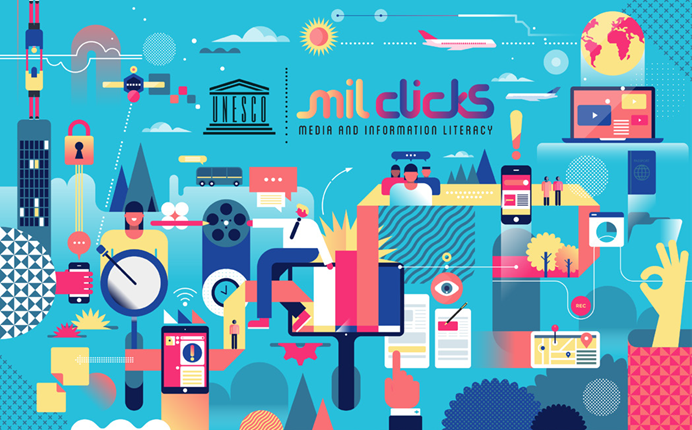
Learn how to become Media and Information literate
- Who created this article or news piece? Why do you think that? Why did they make it? Was it to inform you of something that happened in the world (for example, a news story)? Was it to change your minds or behavior? Was it to make you laugh or to get you to buy something?
- Who is the message for? Is it for kids? Grown-ups? Girls? Boys? People who share a particular interest?
- What techniques are being used to make this message credible or believable? Does it have statistics from a reputable source? Does it contain quotes from a subject expert?
- Who will benefit from this message being transmitted? Who will lose or be affected by the information generated or shared? What freedom are you gaining by using certain information platforms? What freedoms are you losing?
- What details were left out, and why? Is the information balanced with different views -- or does it present only one side? Do you need more information to fully understand the message?
- How did the message make you feel? Do you think others might feel the same way? Would everyone feel the same, or would certain people disagree with you?
These are many questions but they are necessary to achieve a more sustainable information, media and digital ecology. The questions listed here are not exhaustive. What questions would you add?
Media and Information Literacy helps stimulate people’s critically thinking capacities in questioning the world around us and the information or content we access, create or transmit.
Multi-Donor Programme for Freedom of Expression and Safety of Journalists (MDP)
The MDP serves to further strengthen UNESCO work at a global, regional, and national levels, by channeling funds towards emerging priorities and the most pressing needs to achieve its mandate on freedom of expression. It enables UNESCO Communication and Information Sector to address complex issues through the design and implementation of holistic medium and long-term interventions at national, regional and global levels. The clear advantage of this mechanism is that it allows UNESCO and its partners to achieve greater impact and sustainability, whilst reducing fragmentation of activities in the same field.


